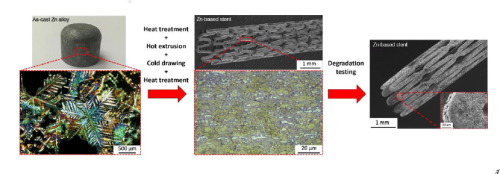Acta Biomaterialia ( IF 9.7 ) Pub Date : 2018-03-10 , DOI: 10.1016/j.actbio.2018.03.005 Ehsan Mostaed 1 , Malgorzata Sikora-Jasinska 2 , Jaroslaw W Drelich 3 , Maurizio Vedani 4

|
The search for biodegradable metals with mechanical properties equal or higher to those of currently used permanent biomaterials, such as stainless steels, cobalt chromium and titanium alloys, desirable in vivo degradation rate and uniform corrosion is still an open challenge. Magnesium (Mg), iron (Fe) and zinc (Zn)-based alloys have been proposed as biodegradable metals for medical applications. Over the last two decades, extensive research has been done on Mg and Fe. Fe-based alloys show appropriate mechanical properties, but their degradation rate is an order of magnitude below the benchmark value. In comparison, alongside the insufficient mechanical performance of most of its alloys, Mg degradation rate has proven to be too high in a physiological environment and corrosion is rarely uniform. During the last few years, Zn alloys have been explored by the biomedical community as potential materials for bioabsorbable vascular stents due to their tolerable corrosion rates and tunable mechanical properties. This review summarizes recent progress made in developing Zn alloys for vascular stenting application. Novel Zn alloys are discussed regarding their microstructural characteristics, mechanical properties, corrosion behavior and in vivo performance.
Statement of Significance
Numerous studies on magnesium and iron materials have been reported to date, in an effort to formulate bioabsorbable stents with tailorable mechanical characteristics and corrosion behavior. Crucial concerns regarding poor ductility and remarkably rapid corrosion of magnesium, and very slow degradation of iron, seem to be still not desirably fulfilled. Zinc was introduced as a potential implant material in 2013 due to its promising biodegradability and biocompatibility. Since then, extensive investigations have been made toward development of zinc alloys that meet clinical benchmarks for vascular scaffolding. This review critically surveys the zinc alloys developed since 2013 from metallurgical and biodegradation points of view. Microstructural features, mechanical, corrosion and in vivo performances of these new alloys are thoroughly reviewed and evaluated.
中文翻译:

用于可降解血管支架应用的锌基合金。
寻找机械性能等于或高于目前使用的永久性生物材料(例如不锈钢、钴铬和钛合金)、理想的体内降解率和均匀腐蚀的可生物降解金属仍然是一个开放的挑战。镁(Mg)、铁(Fe)和锌(Zn)基合金已被提议作为医疗应用的可生物降解金属。在过去的二十年中,人们对镁和铁进行了广泛的研究。铁基合金显示出适当的机械性能,但其降解率比基准值低一个数量级。相比之下,除了大多数合金的机械性能不足之外,镁在生理环境中的降解率也被证明过高,并且腐蚀很少均匀。在过去的几年中,生物医学界一直在探索锌合金作为生物可吸收血管支架的潜在材料,因为它具有可容忍的腐蚀速率和可调的机械性能。本综述总结了开发用于血管支架应用的锌合金的最新进展。讨论了新型锌合金的微观结构特征、机械性能、腐蚀行为和体内性能。
重要性声明
迄今为止,已经报道了许多关于镁和铁材料的研究,以努力配制具有可定制的机械特性和腐蚀行为的生物可吸收支架。关于镁的延展性差和显着快速腐蚀以及铁的非常缓慢降解的关键问题似乎仍未得到理想的解决。由于其良好的生物降解性和生物相容性,锌于 2013 年被引入作为一种潜在的植入材料。从那时起,人们对满足血管支架临床基准的锌合金的开发进行了广泛的研究。本综述从冶金和生物降解的角度对 2013 年以来开发的锌合金进行了批判性调查。对这些新合金的微观结构特征、机械、腐蚀和体内性能进行了彻底的审查和评估。


























 京公网安备 11010802027423号
京公网安备 11010802027423号